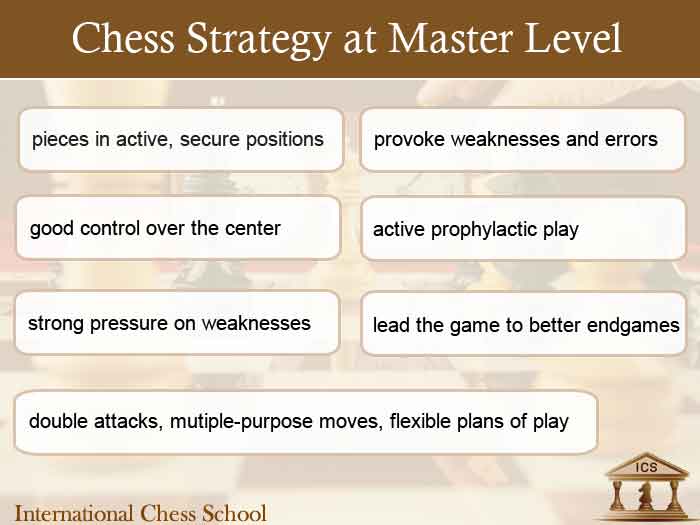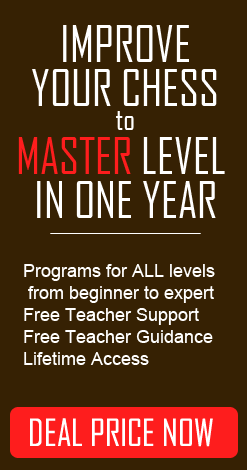7 Grandmaster Chess Strategy Techniques

A grandmaster is first and foremost an expert in chess strategy! However, this is not the same thing as being an expert tactician. Actually, there are many masters and grandmasters who are not good tacticians at all. In spite of this, they win game after game because of their brilliant positional style. They 'just' use their strategic awareness to 'suffocate' their opponents and avoid complications altogether. As a matter of fact, if there is no natural talent for tactics, this isn't too much of a problem. But a good strategist is always a strong player.
So, there is really good news if you want to become a strong chess player. That is, you can improve your strategy from beginner to master level. It can be done in one to five years depending on your starting level and the time that you have for study. Then, it is of first importance to follow a structured, long-term training program. This should be based on both strategy lessons and positional exercises.
The following article lays out some ideas and tips about chess strategy for beginners. But, if you want to become a strong player, we have something better for you! This is our school's core course, the Grandmaster Package. It comes with advanced lessons, exercises and annotated games covering strategy, the middlegame, calculation methods, and complex endgames. In addition, you'll have free and unlimited teacher support and guidance.
Grandmaster Package™
 CHESS TRAINING FOR HIGH PERFORMANCE
CHESS TRAINING FOR HIGH PERFORMANCE
A chess grandmaster is a complete player who has a good technique in all the phases of the game. However, what makes a big difference is the set of powerful strategies that they use. In the following article, we present 7 'deadly' chess strategies of a grandmaster.
Chess Strategy #1
All the pieces in their best positions
One of the most important chess strategies that grandmasters use is to place each of their pieces in their best possible positions. They are grandmasters because they do that very fast. On the other hand, their weaker opponents do not always know what is the best place for each of their own pieces.
Although the two armies are of the same quantitative value, the pieces of the master seem to be stronger. Why's that? Because they know to place them in safer outposts, with more activity, completing more tasks and with better cooperation with the other pieces. After a few moves, the pieces of the grandmaster seem to cover the whole board and control all the key squares.
From the opening, the master will develop all his pieces fast and in the best possible positions. In the middlegame, the pieces will collaborate in a harmonious way to create an active plan of play. At the same time, the grandmaster's pieces hamper the opponent's piece-coordination.
The chess master will improve the position of their pieces to the best strategic position before the final strike. If you want to see great examples, study the games of Anatoly Karpov. You will see that he prepares the final strike with very meticulous precision. He brings all his resources to the right places. This way, an opponent will have almost no chance.
Remember!
A good chess strategy is to imagine the best possible position for each of your pieces and then to try to bring them there.
Chess Strategy #2
Strong control over the center
From the center, the pieces go faster and easier to any place on the board, and so the chess master will always try to control this area.
In the opening and middlegame, the master will try to control at least 2 out of 4 squares in the center, and as many squares as possible in the large center (the c3-c6-f6-f3 square). In the endgame, the king is usually better close to the center, where he becomes as strong as a minor piece.
Every active operation will take into consideration the center. Before the master will start an attack on a flank, he/she will secure the center first. If the other player starts an attack on a flank, a very strong reaction is to counter-attack in the center.
Remember!
A good control over the center is a must if you want your plans and strategies to work.
Chess Strategy #3
Pressure on the weaknesses
As a sore point brings troubles to a whole body, a positional weakness is a breach and an object of attack for the opponent.
When there is a weakness, the grandmaster will immediately start to press there with all his forces until his opponent cannot hold the position anymore. Indeed, the grandmaster attacks you where you are weakest – not strongest – and hurts you there the most.
The continuous pressure on a weakness also brings the initiative. The player with the initiative can carry on with his tasks easier as he is in attack mode while his opponent has a passive role and just defends.
Remember!
A guaranteed good chess strategy is to discover the weaknesses in your opponent's camp and attack right there.
Chess Strategy #4
Provoking weaknesses and mistakes
But what if there are no weaknesses? In that case, the grandmaster will do anything to provoke them!
To create weaknesses in the opponent's camp, the grandmaster plays fine chess strategy, using all his creativity and tricky techniques. The strategy of weakening squares, pawns, or the opposing king's position is a real grandmaster's technique. We teach the complete strategy of provoking weaknesses in our principal chess course, the Grandmaster Package.
You'll often hear among chess players something like this: "The position was equal but my opponent won by luck. If I had not played that wrong move, the game was a draw." Actually, the mistakes are provoked by a cunning technique of play or, simply, by a better management of the nervous tension.
A treacherous strategy of the grandmasters is to use even their opponent's fear! The grandmaster will place his pieces in positions that look threatening, but which actually lack any real threat. Their opponent will think that the grandmaster must have something and will play unnecessary moves that, in fact, only weaken their own position.
It is a war on the chess board and nervous tension plays an important role. Nerves of steel have assured Magnus Carlsen supremacy in the chess world.
Remember!
Use fine chess strategy to provoke weaknesses in your opponent's camp. If that is not enough, make use of any strategic trick to outsmart your opponent.
Chess Strategy #5
Suffocate opponent's resources
Also called prophylaxis, this strategy is a real art.
All world champions were amazing at 'suffocating' their opponents. Look at the games of Capablanca, Botvinnik, Petrosian or Karpov and you will see many formidable examples of 'simple' play. Their games may look simple and logical, but what is behind that simplicity? It is advanced prophylactic play. Their opponents had not even touched the ball at all. The world champions knew how to restrict their opponents' counter-play to the minimum and then they were free to execute their plans with that characteristic 'simplicity'.
Remember!
Do not let your opponent make his/her own plans. Obstruct their active ideas as early as possible and then you'll be free to execute your plans!
Chess Strategy #6
Double attack, multiple purpose moves and flexible strategy
A good chess player can defend against an attack. However, it is much more difficult to defend against two or more attacks simultaneously.
The most basic example in chess is the rule of the square in endgames, where the king moving diagonally approaches two points simultaneously.
The grandmaster knows how to make plans of play and find moves with multiple purposes. Then, while you try to defend against his strongest threat, you'll weaken your defense on the other part of the board.
Alexander Alekhine, former world chess champion, was well known for his skilful ability to play on both flanks of the board. Study his strategy and you'll gain a lot.
This strategy is also used together with the fourth one – creating two weaknesses that are afterwards attacked at once (the double attack).
Remember!
A very powerful chess strategy is to choose moves and plans with multiple purposes or threats. So, opt for a flexible strategy whenever possible.
Chess Strategy #7
Lead the game to a technically won endgame
Many games at master level are decided by the strategy of creating a better endgame.
When the chess master spots a long-term weakness in the opponent's camp, like a bad pawn structure, he will be happy to lead the game to the endgame stage. In the endgame, the weaknesses become more critical as there are fewer possibilities for counter-play and the master can win 'effortlessly'. Of course, winning complex endgames requires an advanced technique of play.
We study this strategy and technique of play in Months 10 to 13 of the Grandmaster Package.
Remember!
In the endgame, the fight is less complicated and the weaknesses can be exploited easier.
It's your turn!
The complete chess strategy that makes a chess player a master is taught in great detail in our core chess course, the
Grandmaster Package ».
How Good Can You Become at Chess in One Year with
Professional Chess Lessons, Tests and Teacher Support?
 GRANDMASTER PACKAGE
GRANDMASTER PACKAGE

